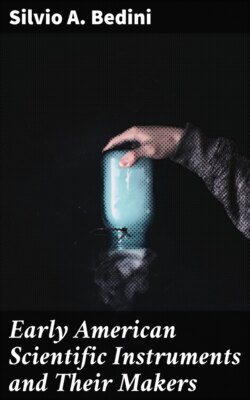Читать книгу Early American Scientific Instruments and Their Makers - Silvio A. Bedini - Страница 13
На сайте Литреса книга снята с продажи.
Andrew Ellicott
ОглавлениеTable of Contents
A name closely associated with that of the Rittenhouse brothers was that of Andrew Ellicott (1754–1820) of Solebury, Pennsylvania, and Ellicotts Mills, Maryland. Andrew was the son of Joseph Ellicott, the clockmaker and pioneer industrialist who founded Ellicotts Mills. Although a Quaker, Andrew (fig. 9) served in the Revolution, and he became one of the most distinguished engineers of the new republic. He worked as a clockmaker and instrument maker from 1774 to 1780. In 1784 he ran the boundary between Virginia and Pennsylvania and in the following year he was a member of the survey that continued Mason and Dixon's line. In 1785 and 1786 he served on the Pennsylvania commissions that surveyed the western and northern boundaries of the state, and in 1789 he served on the commission that fixed the boundary between New York and Pennsylvania. Between 1791 and 1793 he surveyed the site of the city of Washington, D.C., and redrew L'Enfant's plan for the city.
In early 1793 Ellicott was appointed commissioner by the Commonwealth of Pennsylvania for the project of viewing and locating a road from Reading to Presque Isle, now Erie. It was an extremely difficult undertaking, but Ellicott completed the work by the autumn of 1796, including laying out the towns of Erie, Warren, and Franklin.
In May 1796 Ellicott was commissioned by President Washington to survey and mark the boundary line between the United States and the Spanish Province of Florida in accordance with the provisions of the Pinkney-Godoy Treaty of October 27, 1795. This line was to begin at the point where the 31st parallel of north latitude intersected the Mississippi River, and to proceed thence along that parallel eastward to the Appalachicola River for about 400 miles.
In 1801 Ellicott was offered the position of surveyor general of the United States by President Jefferson. Ellicott declined, but subsequently accepted the secretaryship of the land office of Pennsylvania, a post he held until 1808.
In 1811 Ellicott became commissioner to represent Georgia in locating the Georgia-North Carolina boundary, a project on which he was engaged for the major part of the following year.
In 1815 President Madison appointed Ellicott professor of mathematics at West Point, with the rank of major. This is an appointment he kept until his death in 1820. It was interrupted in 1817 when the Government required his services as astronomer to locate a portion of the United States-Canadian boundary in accordance with the fifth article of the Treaty of Ghent.
Figure 10.—Transit and equal-altitude instrument (left) made by Ellicott in 1789 and used by him in the survey of the boundary between the United States and Florida and in other surveys. USNM 152080.
Figure 11.—Zenith sector with focal length of 6 ft., made by David Rittenhouse and revised by Andrew Ellicott. Described in Journal of Andrew Ellicott (Philadelphia, 1803). USNM 152078.
Ellicott was a member of a number of learned societies, including the American Philosophical Society, the Society for the Promotion of Useful Arts of Albany, and of the National Institute of France.
Ellicott constructed a number of instruments for surveying and astronomical observation, and he designed and used others that were produced by his friend David Rittenhouse[10] (see figs. 10, 11). Of particular interest in connection with Ellicott's career as a clockmaker and instrument maker are two advertisements that appeared in the Baltimore newspapers. The first one was in the Maryland Journal and Baltimore Daily Advertiser on April 7, 1778:
Ellicott's Upper Mills, April 4, 1778. Wanted, a person acquainted with the Clock-Making business, and able to work by directions. Such a person will meet with good encouragement by applying to Andrew Ellicott, sen.
The second advertisement, in the same vein, appeared in the May 16, 1780, issue of the Maryland Journal:
Good Encouragement will be given to either Clock or Mathematical instrument makers, by the subscriber, living in Baltimore-Town. Andrew Ellicott.
